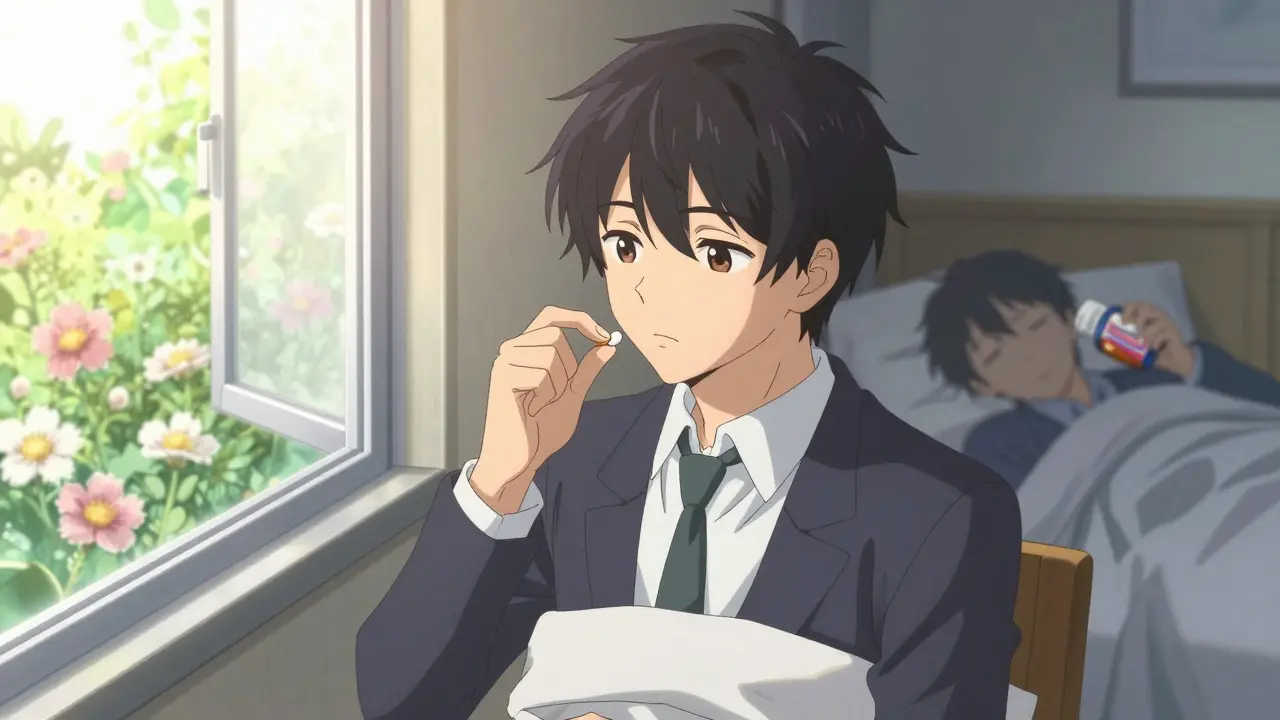It’s wild how something as tiny as a piece of pollen or a fleck of pet dander can wreck your whole day. If you know the feeling—of itchy eyes, runny nose, endless sneezing—you’re probably already tight with Claritin. It shows up on pharmacy shelves and in TV ads, promising a clearer head and some actual peace when allergies strike. But what’s actually going on behind that blue-and-yellow box? And can it really handle those brutal, non-stop sneezing fits? Time to dig into Claritin, what makes it tick, and how it fits into real life for people who’d really like to go outside without sneezing themselves into next week.
What Exactly Is Claritin and How Does It Work?
Let’s get straight to what’s in the box. Claritin’s active ingredient is loratadine, a second-generation antihistamine. The whole point is simple: block histamine, the chemical your body kicks out when it thinks you’ve touched or inhaled something dangerous—pollen, ragweed, dust mites, even pet hair. Most of the time, these things are no big deal, but for allergy-prone folks, your immune system basically loses its mind over them.
Here’s the twist: Claritin goes after the H1 histamine receptors in your body. When you take it (usually as a once-daily pill), it hangs around in your system for a good 24 hours, blocking histamine’s effects. This means less sneezing, a calmer nose, eyes that don’t feel like sandpaper—and maybe most important for a lot of us—no zombie-like drowsiness that comes with many old-school allergy pills. In fact, loratadine was developed specifically to avoid the grogginess that made earlier antihistamines a problem for drivers, students, or anyone who needs their brain awake and working.
This isn’t just marketing spin. Clinical studies have tracked thousands of allergy sufferers and found that loratadine effectively cuts down on sneezing, itchy/watery eyes, and nasal runniness—without making you feel like you stayed up all night. According to published research in The Journal of Allergy and Clinical Immunology, loratadine provides major symptom relief in at least 70% of adults with seasonal allergies. Its effects usually start about one to three hours after you swallow the tablet, peaking around the 8-hour mark and lasting through the day.
Why not just power through allergies without meds? Well, unsubtle as it sounds, untreated hay fever is linked to missed work, poor sleep, crummy grades, and even higher risks for sinus and ear infections—stuff nobody’s got time for. Most users find Claritin helps them get back to normal routines: hitting the gym, making it through back-to-back calls, or just going out for food with friends without looking like they’ve been crying their eyes out. Even kids as young as two years old can use a children’s version when cleared by their doctor.
Take a look at how loratadine’s big perks compare with some other well-known antihistamines:
| Antihistamine | Onset (minutes) | Duration (hours) | Drowsy side effects? |
|---|---|---|---|
| Claritin (loratadine) | 60-180 | 24 | Rare |
| Benadryl (diphenhydramine) | 15-60 | 6-8 | Very common |
| Zyrtec (cetirizine) | 20-60 | 24 | Somewhat common |
| Allegra (fexofenadine) | 60 | 24 | Rare |
So if you want a no-nap-needed, all-day fix, claritin tends to lead the pack (or at least tie for first place).

Using Claritin: Tips, Real-World Advice, and Possible Side Effects
Let’s get into real talk: how should you use Claritin if you want the best results? For starters, don’t wait until your allergies hit full blast. The best move is to take a dose before your triggers come around—that means, start early in allergy season or pop a pill right before mowing the lawn or attending your neighbor’s backyard BBQ, especially if their cat likes to say hello. Timing helps your system shut down the allergy response before it ramps up.
Another smart play is to keep track of what actually triggers your symptoms. Some people only need Claritin during peak pollen months, while others, especially those with pet allergies, swear by daily use all year. Your doctor or pharmacist can help you figure out what matches your symptoms best. Most adult doses are 10mg loratadine once daily—more doesn’t work better and may just up your risk of side effects, so stick to the label unless a healthcare pro advises otherwise.
How about for kids? There’s a liquid and chewable version for children, with dosing based on age and weight. And if you’re dealing with the congestion, Claritin-D combines loratadine with pseudoephedrine (a decongestant), but you’ll need to ask at the pharmacy counter and show some ID because of drug regulations.
It’s also worth knowing what Claritin won’t do. It’s built for allergies, not for colds or flu. If you’re feeling sick with body aches and fever, Claritin won’t fix it. And, like most antihistamines, it doesn’t do much if your eyes are red and itchy from staring at screens all day—that’s not histamine, that’s just digital overload.
Lots of people wonder if there are serious side effects to worry about. Most folks breeze through with nothing to report. The most common side effects are headache, dry mouth, maybe a little boredom because allergy symptoms are so much better. In extremely rare cases, someone could have an allergic reaction or fast heart rate. If you have liver issues or other medical problems, it’s worth a quick chat with your doc. But for healthy adults, Claritin is about as low-drama as allergy pills get. It doesn’t usually interact with alcohol or most daily meds, but always double-check if you’re on other prescriptions like erythromycin or ketoconazole (certain antibiotics and antifungals can boost loratadine levels in your blood).
Here’s a handful of helpful, not-so-obvious tips for getting the most from your Claritin habit:
- Take your dose at the same time every day. Set an alarm or put your pill bottle near your toothbrush if it helps.
- If pollen is your enemy, shower and change clothes when you get home to keep allergens out of your bed.
- Try not to pop Claritin on an empty stomach if you’re prone to mild tummy upset (rare, but possible).
- If you use Claritin-D, avoid caffeine or other stimulants to steer clear of feeling jittery.
- Track your symptoms in a simple phone calendar or allergy app—seeing a pattern can help you plan ahead and decide when (or if) you need Claritin daily.
Claritin also gets the thumbs-up for folks who work outdoors, students in exam season, or anyone behind the wheel. That’s because it’s almost entirely non-sedating. Pop one and you’re set for work or study without that foggy brain haze.

Beyond the Box: Claritin in Context with Lifestyle, Research, and Other Options
Sometimes allergy meds get treated like a one-size-fits-all fix, but the reality’s way more personal. Maybe you’ve done the spring pollen dance for a decade, or maybe you picked up a random cat allergy last year, and you’re tired of carrying tissues everywhere. The cool part about Claritin is how well it fits into a modern, busy routine—no weird requirements or strict schedules, just a once-a-day move you can lock in like your morning coffee. It’s available as tablets, gels, chewables, and liquids. Generic loratadine works the same, so there’s no need to stress about the brand if you like to save cash.
What about folks with really stubborn allergies? Combining Claritin with nasal sprays (like fluticasone or mometasone) often gives even better relief by attacking allergy misery from a second direction. And for the unlucky people with constant, year-round symptoms, allergists sometimes recommend immunotherapy (“allergy shots”)—Claritin can still be part of your routine while you work on building up resistance.
There are moments when Claritin just isn’t enough—if your symptoms are way out of control, you’re wheezing, or you get frequent sinus infections, that’s a sign to check in with an allergy specialist. Same thing if Claritin helps but you start getting new symptoms, like rashes, swelling, or tummy pain—a real medical pro can clue you in if something more serious is going on.
It’s also interesting to see what allergy relief looks like worldwide. Data from 2024 shows Claritin is one of the top ten most-used OTC meds in the US, and its generic forms are seriously popular in Europe and Asia. More than 100 million prescriptions for loratadine were filled globally last year—a big hint at just how many lives it touches. And while no allergy med will wipe out allergies entirely, loratadine (Claritin) pops up in dozens of research articles, studied for everything from eczema to hives to how much it helps people sleep better when they’re not sneezing their way through the night.
You might be surprised at how much your allergy triggers shift over time. Someone might start taking Claritin for spring pollen at age 15 and still be using it at 35 for cat hair or dust. Thanks to its non-drowsy profile, it can ride along with you through major life changes—new job, new city, even parenthood (just double-check with your OB/GYN if you’re pregnant or breastfeeding).
People talk a lot about “natural remedies” and whether diet, filters, or local honey will save them from allergies. The numbers show—honestly—no miracle cure, but combining smart strategies helps. Use HEPA filters at home, practice basic hand-washing, and keep windows closed on high pollen days. But on brutal days, Claritin still does the heavy lifting. You can even use an app for real-time pollen counts and plan your meds accordingly. There’s no shame in using science to feel human again.
So next time you feel allergies gunning for you, know that behind the Claritin box is a product with real research, decades of safe use, and a design that fits into regular lives, not just science-lab settings. It’s not about hiding from pollen, pets, or dust—it’s about taking back your day, one symptom-free hour at a time.



